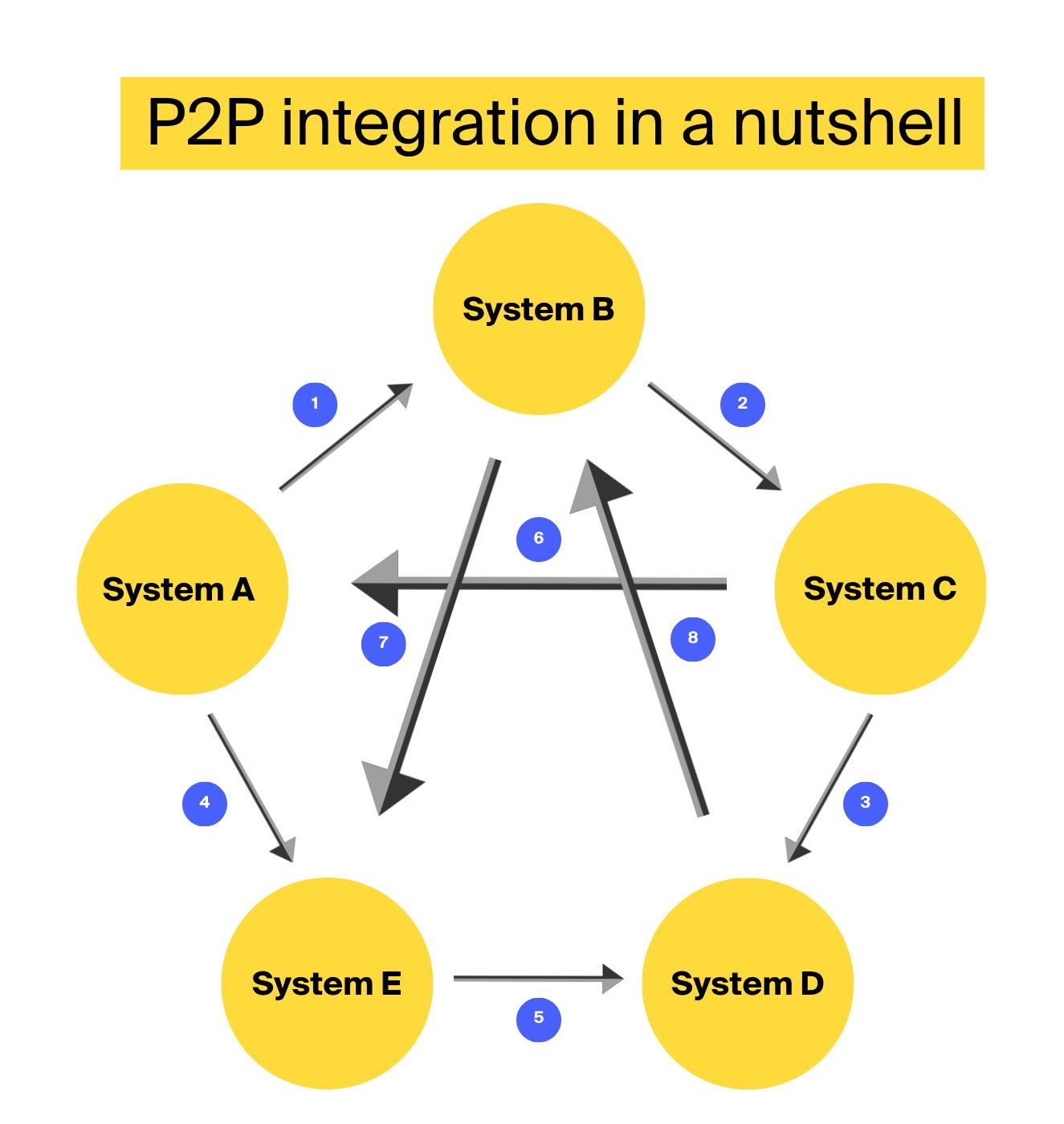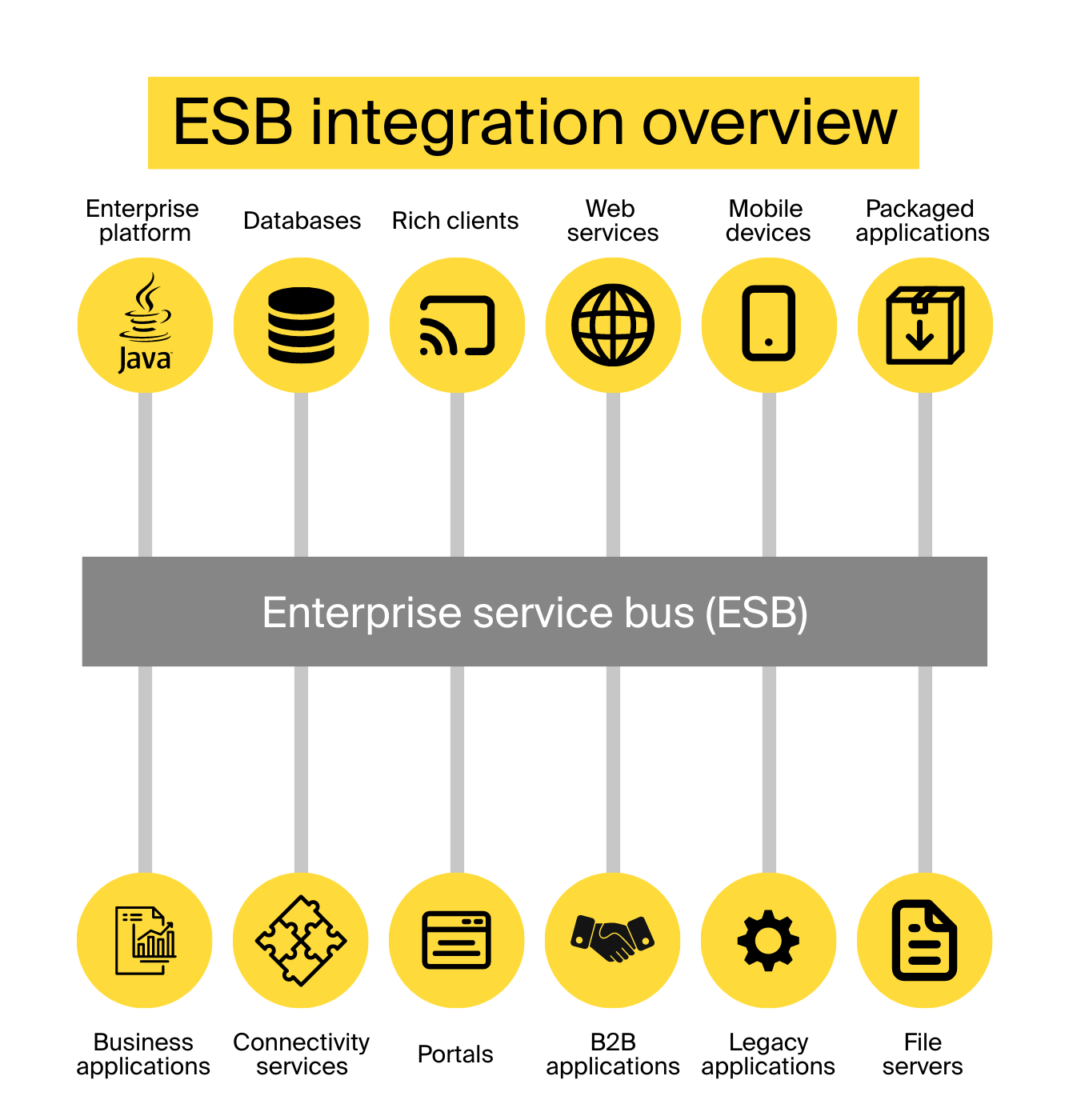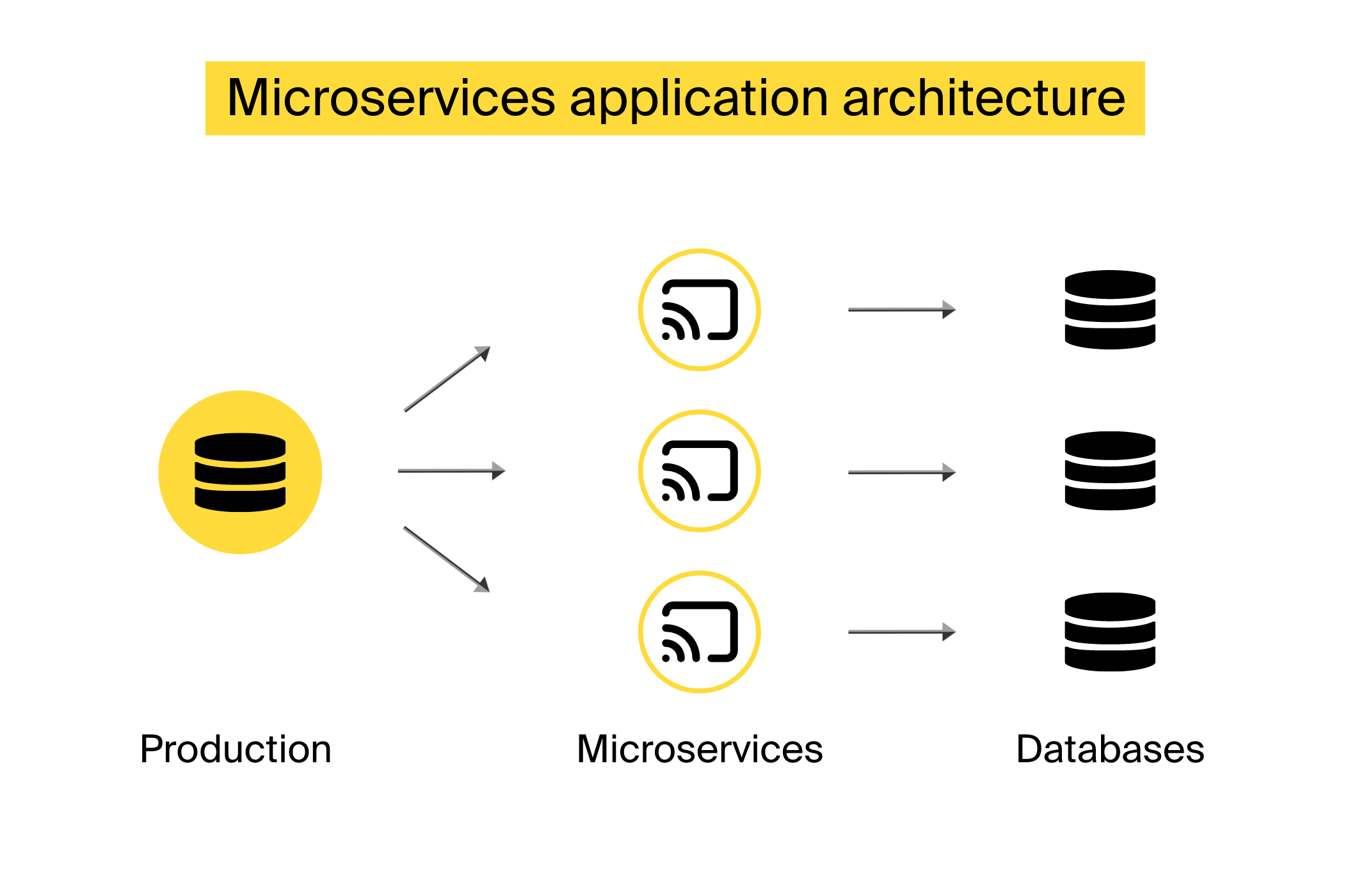What is EAI?
Enterprise application integration (EAI) is the process of bridging the communication gap between different applications within one enterprise, such as inventory, resource planning, and customer relationship management apps.
The goal of EAI is to provide a standardized form of access to all enterprise applications, offer a unified business logic, support data flow among programs without significantly altering database configuration, and make sure that any changes to business data in one spot are immediately reflected in all corresponding databases.
Why is enterprise application integration important?
Businesses typically rely on multiple applications from different vendors in their day-to-day operations. Statistics show that the median number of data sources used within one company is around 400. And according to IDG and Matillion, for some companies this number can go as high as 1,000 sources. Each software has its own flow and data structure. Having all these isolated applications leads to data silos. If data is captured by one application, it’s available in one database and missing in others, making it impossible to have a consistent overarching view.
In addition to offering a unified access to data, EAI allows taking business rules out of enterprise applications and implementing them into the EAI system. This way, companies can replace applications and vendors without the need to re-implement these rules again.
Another important aspect is that software from different vendors will have a distinct look and feel, making it inconvenient for users to experiment with all these applications. EAI provides consistent access through a unified interface to all enterprise programs.
Deploying EAI in your organization brings about the following benefits:
-
Allows various departments across the organization to generate reports with consistent and accurate data
-
Streamlines communication among applications
-
Reduces labor costs on manual data entries
-
Minimizes human error
-
Ensures a common facade for all enterprise applications
-
Facilitates replacing applications and makes your system vendor-agnostic
-
Supports collaboration across departments
-
Streamlines and eliminates inefficiencies in business processes
-
Speeds up your automation efforts
Enterprise application integration examples from our portfolio
Here are two projects from the ITRex portfolio that will help you appreciate what EAI technology means for your business.
Gaining access to company-wide data in the retail sector
A large retailer operating a chain of hypermarkets and grocery stores on an international scale wanted to have a 360-degree view of all its data sources to facilitate reporting and business insight generation. The company tasked ITRex with building an AI-powered business intelligence platform that would allow millions of internal users to access data on demand, analyze it, and generate complex custom reports.
The main challenge of this project was the enormous number of data sources that operated in isolated silos. To overcome this, our team had to integrate data from a large variety of applications, databases, etc., and create a master data repository that would serve as a single source of truth. We also performed data cleansing and enforced strict role-based access for enhanced security.
The resulting platform was user-friendly as it relied on a simplistic search query format that was close to the natural language and even offered a hashtag autocomplete functionality to further facilitate the search. It also contained a report builder feature that would simplify generating and sharing complex reports. The system offered a simple API that allowed for the integration of new apps in the future.
Our client happily reported that, with the new platform, it takes the employees mere minutes to accomplish tasks that previously consumed days.
An AI-powered IoT platform for the logistics sector
A company operating in the logistics sector offers a transportation management system that is used by different actors in the cargo management process. The firm wanted to enhance their system with AI capabilities, give all participants a unified access to data, and allow them to work together. So, our team was set on designing an AI-based collaborative IoT platform.
The resulting solution allowed authorized platform users to access different applications within the system through a unified UI. It also integrated data from multiple services and applications offered by the actors on the platform and provided an API for incorporating third-party services into the system. For instance, we connected it with an external payment system of JP Morgan.
In addition to all the integration services mentioned above, we implemented the following features:
-
An AI-powered recommendation tool that analyzes payment factors, predicts shipment costs, and suggests suitable shipment partners
-
A dashboard for access and permission management
-
A GPS tracking system that can monitor cargo status
-
An automated documentation feature to assist with paperwork
Enterprise application integration models
There are several common EAI architectures that a company can choose from. You can either select and apply a unified architecture throughout the enterprise or combine multiple EAI models in one project.
Point-to-point (P2P) integration
P2P integration relies on a script to extract data from one solution, reformat it, and transmit it to another application. So, it requires a unique connector program to integrate each pair of applications.
This approach is effective when integrating only a few applications but becomes inefficient in managing larger systems as the number of custom scripts grows. This architecture is not scalable.
Hub-and-spoke integration
Unlike the previous model, this one uses a central hub, which connects all the integrated applications together. Each solution sends its data to the hub that reformats and transmits it to the destination app.
As there is no need to establish a direct connection between each pair of applications, hub-and-spoke architecture is easier to scale. However, all the communications go through the hub, which operates under a heavy load and represents a single point of failure. Also, this model still needs maintenance and human intervention to add new applications and support the existing ones.
Bus integration
This model establishes communication between systems using a service-oriented architecture (SOA). Bus integration improves on the previous model, as it doesn’t require constant human intervention to route reformatted data, as all this is governed by predefined rules and policies.
This model is rather lightweight and suitable for integrating a large number of systems. And it’s easy to scale as applications can be added/removed with minimal changes to the EAI software. On the other hand, the bus-based model is hard to configure and maintain, and the communication speed is lower than in the previous models.
Middleware-based integration
Middleware is software that operates between an application’s user interface and an operating system of a computer. In the context of enterprise application integration, middleware acts as an intermediary that facilitates data translation and exchange between distributed applications. Companies can deploy different types of middleware, such as application server or database middleware.
As in the previous models, middleware simplifies the integration by avoiding constant human intervention. It’s easy to scale and make changes to the applications involved. However, if you deploy a ready-made middleware, it might limit your tech stack to the options supported by this vendor. Additionally, middleware can be rather costly, and it presents a single point of failure.
Microservices-based integration
Microservices are small lightweight apps that serve one specific purpose and deliver services to other applications. This is the current standard for integrating cloud-based enterprise applications.
Deploying microservices makes the EAI solution fault-tolerant, as a failure of one service can’t bring down the entire system. It’s also easier to troubleshoot each service independently than trying to locate a problem in a large monolith solution. Finally, this model allows us to diversify the tech stack used for microservice implementation. However, if the microservices are poorly organized and optimized, they can cause communication overhead and performance delays. Moreover, such a system is harder to secure, as each microservice has its own authentication mechanisms.
You can find more on the benefits of microservices on our blog.

Step-by-step EAI implementation plan
Here is a detailed implementation guide that will help you plan and implement the integration process.
Step 1: Conduct an assessment of your enterprise application integration needs and identify integration requirements
Study the company’s applications and interview stakeholders from different departments to identify the key business needs. Take note of any problems they want to resolve and the goals they aim to achieve. Based on this information, put forward the integration requirements. In these interviews, you can include the following questions:
-
Which applications/systems do you want to integrate?
-
Which data will be shared among them?
-
What is the structure of this data?
-
Which integration protocols do you want to use?
-
Which processes will be impacted by the integration?
-
What are the additional security requirements?
-
What are your performance metrics?
-
What is the desired outcome of the integration?
Step 2: Decide on the architecture model
To determine which EAI model or a combination of models will better serve your unique needs, consider the following set of paraments:
-
Your answers to the questions presented in Step 1
-
The size of your system and its complexity
-
Non-functional requirements, such as scalability, security level, etc.
-
The budget available for integration efforts
Step 3: Identify the integration tech stack
You can determine which tech stack is the best fit by addressing the following:
-
Analyze your existing systems to understand which technologies are compatible with it
-
Take into account the selected integration architecture from Step 2
-
Consider non-functional requirements, such as performance, scalability, maintainability, reliability, compatibility, availability, etc.
-
Define security requirements, such as authentication mechanisms, encryption, etc.
-
If the integration system needs to handle large volumes of data, use big data processing tools
-
Look into the regulations and policies of the country of operations
-
Consider budget limitations, which are particularly relevant for small firms
Step 4: Design and implement your EAI system
The selected integration model and tech stack will largely determine how you proceed with the implementation.
Identify which system parts you want to integrate. Then proceed with building various integration components, such as connectors and adaptors, and implement the integration logic.
Decide on how the selected components will communicate with each other and exchange data by designing the integration interface. This includes:
-
Determining the interface type
-
Deciding on the message format
-
Formalizing the extract transform load (ETL) process, if needed
-
Performing data mappings
-
Ensuring security is in place
-
Setting up error handling
Perform unit and integration tests. Unit tests will help you examine the performance of individual components in isolation, while integration tests will evaluate the interoperability and interaction between various components and gauge the performance of the solution as a whole.
Step 5: Deploy, monitor, and maintain the integration
Set up strong security mechanisms and deploy the EAI tools in the production environment. Make sure the software allows for real-time monitoring of various performance factors, such as CPU and memory utilization, responsiveness, etc. Also, pay attention to error messages and go through system logs to identify any potential issues.
Regularly update the integration system to ensure that it keeps up with the updated versions of enterprise applications.
Evaluate the integration and check whether it satisfies the business needs that you identified in Step 1.
Enterprise application integration challenges
While going through the implementation steps presented above, you can encounter the following challenges:
-
Increased security risks. When data resides in siloed systems, it’s more protected. Integration introduces security vulnerabilities, as it becomes easier to gain access to data for both legitimate users and malicious intruders. Therefore, companies are advised to implement strong data access control mechanisms, such as multi-factor authentication. Additionally, firms implementing EAI projects need to pay attention to network security and have an incident response plan in place to minimize damage in case of a breach.
-
Legacy systems integration. Legacy systems often use their proprietary protocols and specific data formats, which makes it difficult to share data with modern applications. Furthermore, the data they generate can be incomplete and inconsistent with other applications. Companies can opt for building custom APIs to streamline data exchange or use integration middleware solutions to bridge the gap with modern systems.
-
Scalability. When your business expands, there might be a need to incorporate additional applications and systems. And as these data sources grow, there might be spikes in workload that the integration system should be able to handle. There are several ways to approach the scalability challenge:
-
Opt for cloud-based EAI technologies that can scale on demand
-
Use load balancing to distribute growing workload among multiple servers
-
Design your EAI solution with scalability in mind, to begin with
-
-
The need for a governance framework. The enterprise application integration efforts are likely to involve multiple teams and even departments. All these people will have different expertise and ways of working. To make sure they all follow the same path, companies need to produce dedicated guidelines and policies. This includes, but is not limited to, the following four aspects:
-
Come up with a change management strategy. This strategy will guide employees and show them how to navigate EAI-related challenges with minimal work disruption.
-
Assign roles and responsibilities. Distribute EAI-associated tasks among the teams involved to manage expectations.
-
Define communication guidelines. Collaboration among teams is key to successful integration, so companies need to set up status meetings, adopt tracking tools, open communication channels, etc.
-
Monitor performance. When the integrations are in place, you will have to evaluate the system’s performance based on predefined metrics. It can include aspects like data availability, response time, etc.
-
To sum up
Now you know what enterprise application integration is and understand that implementing an EAI system will help you gain a unified access to your company’s data in real time, give a consistent look-and-feel to all your applications, and move business rules implementation to the EAI instead of repeating them in each new software.
When approaching a complex initiative, such as EAI, pay attention to both the human factor and the technical side. Help your people go through the transformation by establishing a detailed governance framework. And on the technical side, consult ITRex enterprise software development company or another trusted tech partner. We will help you select the best-suited EAI architecture, consider your organization’s specifics, such as legacy systems, and keep scalability in mind.
















